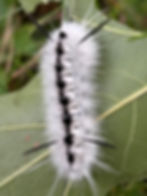Tale of Two Tussocks
- jsrhollis
- Sep 12, 2024
- 3 min read
Updated: Mar 9
Caterpillars Part I
By Martha Siegel


Let’s take a minute to talk tussock moth caterpillars; specifically, the hickory tussock moth caterpillar (Lophocampa caryae) and the milkweed tussock moth caterpillar (Euchaetes egle), both of which are native to Maine. I will zero in on these two striking species for the simple reason that many of us have noticed them munching, marching, and multiplying their way through our yards and gardens this past summer. They certainly pose questions for curious observers and perhaps even raise a few alarm bells. SHOULD we be alarmed? What is with these fuzzy eating machines?
Consider the hickory tussock moth caterpillar, which is mostly white, with black accents. They feast on the leaves of a variety of tree species in Maine. In my yard, they seem to enjoy birch and oak trees. Apparently, they do not usually cause severe or widespread damage (unlike our recent troubling bout with spongy moth caterpillars.) This is partially a result of the fact that most of their feeding frenzy happens late in the season when trees are close to losing their leaves anyway. These caterpillars make their way into unlikely places, like the edges of 5-gallon buckets, on the inside screens and walls of our screen porch, on our car, or in my hair, to name a few. I have seen them dangling from threadlike strands suspended from tree limbs. When they are disturbed or flicked, they release numerous hairs.
So far, all of this is tolerable except when their hairs come into contact with my spouse’s skin. He breaks out in a seriously itchy, raised, and long-lasting rash. So, he takes great care to shower and launder after outdoor chores. When these caterpillars finish feasting in the fall, they form fuzzy gray cocoons in the leaf litter (which are also to be avoided by sensitive individuals) and remain there for the winter. During June and July, the moths emerge, lay eggs, and begin the cycle again. Most birds do not enjoy these caterpillars, but there are plenty of predators for the adult moths. Populations can also be checked by pathogens and parasites.
Now, consider the boldly marked orange, black, and white milkweed tussock moth caterpillar. I have noticed this creature in the past decade but never more abundantly than during this summer. These caterpillars use any milkweed species as host plants. They also use dogbane, which is in the same family as milkweed, but apparently not closely related enough for monarch larvae, which rely exclusively on milkweed. These caterpillars emerge from groups of eggs laid by the moths on the undersides of milkweed leaves. From there, it is an all-out marathon of eating and growing, which is what has concerned me as a monarch enthusiast.
Although they do not pose a direct threat to monarch caterpillars, I have worried about competition for food as they, through sheer numbers, have literally stripped some of my milkweed plants. Advice is either to remove leaves with offending caterpillars to somewhere else, or simply plant more milkweed in your yard and garden so that there will be food enough for all. In any case, the mature caterpillars build cocoons in the leaf litter for the winter and emerge in the spring as moths to begin a new generation, similar to the hickory tussock moth.
As a Habitat For All Garden volunteer, I have been traveling my own journey as a gardener. This includes working to see the bigger picture of what we are trying to accomplish by stewarding habitat around our homes and beyond. At its best, a thriving yard and garden is an entire ecosystem, which plays host to the life cycles of a multitude of living things. Within that web, there are complex relationships full of life and death, competition, and interdependence. I suppose that I am prepared to welcome the native tussock moth caterpillars as occasionally annoying but important members of the network of species inhabiting this spectacular place we all share.
References:
Photo Credits:
Hickory Tussock Moth & Milkweed Tussock Moth photo by Martha Siegel

